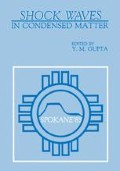Abstract
Explosively launched expanding ring tests have been used to extract material flow stress at strain-rates from 103 to 3 x 104 sec−1. Computer simulations of such tests using a strain-rate independent, but work hardening constitutive model were analyzed by the same methods used experimentally. Results of this analysis also showed an apparent strain-rate effect. Further examination of the computer simulations has shown that much, if not all, of the measured strain-rate effect is an increased flow stress due to a plastic strain, ɛL, that is locked in during the initial stages of launch. At a larger launch velocity, hence a larger strain-rate, ɛL is also larger. The value of ɛL is sensitive to details of the launch dynamics.
Access this chapter
Tax calculation will be finalised at checkout
Purchases are for personal use only
Preview
Unable to display preview. Download preview PDF.
References
C. R. Hoggatt and R. F. Recht, “Stress-Strain Data Obtained at High Rates Using an Expanding Ring”, Experimental Mechanics, (9), 441–448, Oct. 1969.
A. E. Carden, P. E. Williams, R. R. Karp, Comparison of the Flow Curves of 6061 Aluminum Alloy at High and Low Strain Rates, in,: Shock Waves and High-Strain-Rate Phenomena in Metals, M. A. Meyers and L. E. Murr, eds., Plenum, 1981, pp. 37–50.
M. L. Wilkins, R. D. Streit, J. E. Reaugh, “Cumulative-Strain-Damage Model of Ductile Fracture: Simulation and Prediction of Engineering Fracture Tests”, Lawrence Livermore National Laboratory, Livermore, CA, UCRL-53058 (1980).
M. L. Wilkins, “Calculations of Elastic-Plastic Flow”, in: Methods in Computational Physics, Vol. 3 Fundamental Methods in Hydrodynamics, B. Alder, ed., Academic Press, N. Y., 1964, pp. 211–263.
C. J. Maiden and S. J. Green, Compressive Strain Rate Tests on Six Selected Materials at Strain Rates from 10-3 to 104 in./in./sec, J. Appl. Mech., p. 496, Sept. 1966.
C. H. Mok and J. Duffy, “The Dynamic Stress-Strain Relation of Metals as Determined from Impact Tests with a Hard Ball”, Brown Univ. Rept. Nonr-562(20) 137, June 1964.
A. L. Austin and R. F. Steidel, Jr., A Method for Determining the Tensile Properties of Metals at High Rates of Strain, Proc. SESA. XVII (1), pp. 99–114, 1959.
U. S. Lindholm and L. M. Yeakley, High Strain-Rate Testing: Tension and Compression, Experimental Mechanics, 8 (1), pp. 1–9, 1968.
Author information
Authors and Affiliations
Editor information
Editors and Affiliations
Rights and permissions
Copyright information
© 1986 Plenum Press, New York
About this chapter
Cite this chapter
Reaugh, J.E. (1986). Computer Simulation and Analysis of the Expanding Ring Test. In: Gupta, Y.M. (eds) Shock Waves in Condensed Matter. Springer, Boston, MA. https://doi.org/10.1007/978-1-4613-2207-8_55
Download citation
DOI: https://doi.org/10.1007/978-1-4613-2207-8_55
Publisher Name: Springer, Boston, MA
Print ISBN: 978-1-4612-9296-8
Online ISBN: 978-1-4613-2207-8
eBook Packages: Springer Book Archive

